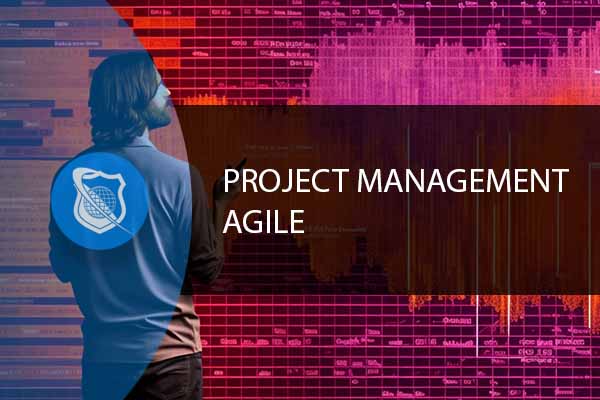Project life cycles define the overall approach and structure of how a project is managed, executed, and controlled from initiation to closure. Different projects require different life cycle models based on their characteristics, requirements, and constraints. Let’s explore four common project life cycle models: predictive, iterative, incremental, and adaptive.
Predictive (Waterfall) Project Life Cycle
In the realm of project management, the predictive project life cycle, often referred to as the waterfall model, has been a fundamental approach for decades. Characterized by its sequential and structured nature, this methodology has been the cornerstone of many successful projects across various industries. In this blog, we’ll explore the predictive project life cycle, its stages, benefits, challenges, and when it’s most suitable to use.
Understanding the Predictive (Waterfall) Project Life Cycle:
The predictive project life cycle is a well-defined, sequential approach to project management. It’s often visualized as a waterfall, where each phase flows into the next without going back. Unlike agile methodologies, which embrace flexibility and iterative development, the predictive model is ideal for projects with clearly defined requirements and a stable scope.
Stages of the Predictive Project Life Cycle:
- Requirements Gathering: The project’s requirements are meticulously gathered and documented. Stakeholders’ expectations are aligned, and the project scope is set.
- Planning: A comprehensive project plan is crafted, detailing the project’s scope, timeline, resources, budget, and deliverables. Risks are identified and mitigation strategies are formulated.
- Design: Based on the requirements, the project’s architecture, system design, and specifications are developed. This stage lays the groundwork for implementation.
- Implementation: The actual development work begins. Teams follow the design specifications to build the product or solution as outlined in the plan.
- Testing: The product is rigorously tested to ensure it meets the specified requirements. Any defects or issues are identified, addressed, and resolved.
- Deployment: The product is deployed to the target environment, whether it’s a production server or end-user devices.
- Maintenance and Support: Once deployed, the product is monitored and maintained to address any issues or updates that arise.
Benefits of the Predictive Project Life Cycle:
- Clear Structure: The linear nature of the waterfall model provides a clear roadmap, making it easier to manage and monitor progress.
- Well-Defined Requirements: The emphasis on thorough requirements gathering reduces the likelihood of scope changes during development.
- Documentation: Each phase requires comprehensive documentation, ensuring a detailed record of the project’s progress and decisions.
- Risk Management: Risks are identified and addressed early in the process, minimizing the potential for surprises later on.
Challenges of the Predictive Project Life Cycle:
- Scope Changes: If requirements change after the design phase, it can be challenging and costly to implement adjustments.
- Limited Flexibility: The sequential nature of the model can hinder flexibility when responding to unforeseen challenges.
- Late Discovery of Issues: Defects or issues might not surface until the testing phase, potentially leading to delays or increased costs.
When to Use the Predictive Project Life Cycle:
The predictive model is well-suited for projects where:
- Requirements are stable and well-defined.
- The scope is unlikely to change significantly.
- There’s a need for comprehensive documentation.
- Risk management is a priority.
- There’s a clear understanding of the end product from the outset.
The predictive (waterfall) project life cycle remains a valuable methodology for projects that demand clear planning, structure, and a well-defined scope. By following a sequential approach from requirements gathering to deployment and maintenance, teams can achieve successful outcomes in environments where change is minimal and a structured approach is essential. However, it’s essential to recognize that the predictive model might not be suitable for projects where flexibility and adaptability are paramount. As the landscape of project management continues to evolve, understanding and leveraging the strengths of various methodologies is key to delivering successful projects.
Get This Course and More In Our
Project Management Training - 9 Course Series
Drive Success In Your Organization
Our 9 course Project Managers bundle offers a comprehensive collection of training sessions to help you not just master project management, but also stay ahead in the curve and learn all its new advancements such as Agile techniques, project documentation and planning. Plus, at ITU, we provide the best route for getting your project management certification, (PMP from Project Management Institute), which is recognized world-wide as the gold standard when it comes to elevating your project management skills!
Iterative Project Life Cycle
In the realm of project management, adaptability and responsiveness have become paramount in an ever-changing business landscape. The iterative project life cycle is a methodology that addresses these needs by embracing flexibility, continuous improvement, and collaboration. In this blog, we’ll explore the iterative project life cycle, its stages, benefits, challenges, and scenarios where it thrives.
Unveiling the Iterative Project Life Cycle:
The iterative project life cycle is a dynamic approach that encourages continuous refinement and enhancement throughout a project’s duration. Unlike the linear and structured nature of the predictive (waterfall) model, the iterative approach acknowledges that requirements and solutions can evolve as the project unfolds.
Stages of the Iterative Project Life Cycle:
- Requirements Gathering: Initial requirements are collected, but with an awareness that they might evolve over time.
- Planning and Design: A high-level plan is established, outlining goals, key milestones, and a general direction. Design and planning occur simultaneously.
- Iteration Development: Instead of implementing the entire project at once, small iterations are executed, each producing a tangible deliverable.
- Testing and Feedback: After each iteration, the deliverable is rigorously tested, and feedback is collected from stakeholders and end-users.
- Review and Adjustment: Based on the feedback, the project plan and deliverable are adjusted and refined. Changes might involve additional features, improvements, or modifications.
- Continued Iterations: The development, testing, and refinement process continues through multiple iterations until the project meets its objectives.
Benefits of the Iterative Project Life Cycle:
- Adaptability: The iterative model readily accommodates changing requirements, ensuring alignment with evolving business needs.
- Stakeholder Engagement: Regular feedback loops involving stakeholders foster collaboration and a sense of ownership.
- Risk Mitigation: Issues and risks are identified and addressed early in the project, reducing the likelihood of costly surprises.
- Continuous Improvement: The iterative approach promotes ongoing enhancement, allowing for the incorporation of new technologies and innovations.
Challenges of the Iterative Project Life Cycle:
- Time and Resource Management: The continuous iteration process can demand careful management of time and resources to avoid scope creep.
- Stakeholder Management: Continuous collaboration requires effective communication and engagement with stakeholders.
- Complexity: The iterative model might be less suitable for projects with straightforward requirements that can be completed in one linear phase.
When to Use the Iterative Project Life Cycle:
The iterative model is well-suited for projects where:
- Requirements are subject to change or refinement.
- There’s a need for regular feedback and collaboration.
- Solutions can be developed in smaller increments.
- Continuous adaptation and improvement are priorities.
- Stakeholder involvement is crucial.
In an era where change is constant and innovation is imperative, the iterative project life cycle offers a powerful alternative to traditional approaches. By embracing flexibility, collaboration, and continuous improvement, organizations can navigate complex projects while delivering solutions that align with evolving needs. While the iterative model might not fit every scenario, understanding its strengths and applying it when appropriate can lead to more successful and responsive project outcomes. As the landscape of project management evolves, harnessing the potential of iterative methodologies becomes a strategic advantage in the pursuit of excellence.
Incremental Project Life Cycle
In the realm of project management, where adaptability and responsiveness are paramount, the incremental project life cycle emerges as a powerful approach. This methodology focuses on delivering functional increments of a project over time, allowing for flexibility and continuous improvement. In this blog, we’ll delve into the incremental project life cycle, its stages, benefits, challenges, and the scenarios in which it excels.
Exploring the Incremental Project Life Cycle:
The incremental project life cycle is characterized by its approach of breaking down a project into manageable and deliverable increments. Unlike the linear and rigid structure of the predictive (waterfall) model, the incremental approach acknowledges that projects can evolve as requirements change and stakeholders’ needs adapt.
Stages of the Incremental Project Life Cycle:
- Requirements Gathering: Initial requirements are collected, serving as a foundation for the first increment.
- Planning and Design: A high-level plan is established, outlining key milestones, resources, and the overall direction of the project.
- Increment Development: Each increment involves the development of a functional, deliverable component of the project.
- Testing and Feedback: After each increment, rigorous testing is conducted, and feedback is collected from stakeholders and users.
- Review and Adjustment: Based on feedback, the project plan and deliverables are adjusted and refined for the next increment.
- Continued Increments: The process of developing, testing, and refining continues through multiple increments until the project is complete.
Benefits of the Incremental Project Life Cycle:
- Adaptability: The incremental model readily accommodates evolving requirements and changing priorities.
- Stakeholder Engagement: Regular feedback loops involving stakeholders foster collaboration and ensure alignment with expectations.
- Early Value Delivery: Each increment produces a tangible deliverable, allowing stakeholders to see progress and value early on.
- Risk Mitigation: Issues and risks are identified and addressed incrementally, minimizing the potential for costly surprises.
Challenges of the Incremental Project Life Cycle:
- Managing Scope: Careful scope management is crucial to prevent excessive scope creep and maintain project focus.
- Resource Allocation: Resource allocation needs to be carefully managed across increments to ensure efficient use of time and resources.
- Dependency Management: Dependencies between increments need to be carefully managed to ensure smooth integration and functionality.
When to Use the Incremental Project Life Cycle:
The incremental model is well-suited for projects where:
- Requirements are expected to evolve or become clearer over time.
- Stakeholder collaboration and engagement are priorities.
- Solutions can be developed and delivered in incremental pieces.
- Early value delivery is important to build stakeholder confidence.
- Continuous adaptation and improvement are key project goals.
In an era where change is constant and agility is paramount, the incremental project life cycle offers a dynamic and flexible approach to project management. By delivering functional increments over time, organizations can respond to evolving requirements while maintaining a structured and controlled development process. The incremental model’s strengths in adaptability, stakeholder engagement, and early value delivery make it a strategic choice for projects that demand both innovation and accountability. As project management continues to evolve, harnessing the potential of incremental methodologies becomes a strategic advantage in driving success and delivering exceptional outcomes.
In a world where change is constant and business landscapes evolve rapidly, the adaptive project life cycle, commonly known as Agile, has emerged as a dynamic and responsive approach to project management. This methodology emphasizes flexibility, collaboration, and iterative development to deliver value in the face of uncertainty. In this blog, we’ll explore the adaptive project life cycle, its stages, benefits, challenges, and the scenarios in which it shines.
Unveiling the Adaptive (Agile) Project Life Cycle
The adaptive project life cycle, known as Agile, represents a departure from traditional, linear approaches. Agile focuses on delivering value incrementally, embracing change, and prioritizing customer collaboration throughout the project’s duration.
Effectively Manage Projects Using Agile Project Management
Learn all the core concepts of effectively managing a project using Agile Project Management Methods.
Stages of the Adaptive (Agile) Project Life Cycle:
- Vision and Strategy: The project’s overall vision and strategic goals are defined, providing a clear direction for the team.
- Product Backlog Creation: A product backlog is established, containing a prioritized list of features and requirements.
- Sprint Planning: Short development cycles called sprints are planned, during which a subset of the product backlog items will be completed.
- Sprint Execution: Development takes place in iterations called sprints, typically lasting 1-4 weeks. At the end of each sprint, a potentially shippable increment is produced.
- Daily Stand-Ups: Daily stand-up meetings foster communication, alignment, and transparency among team members.
- Sprint Review: At the end of each sprint, stakeholders and the team review the completed work and gather feedback.
- Sprint Retrospective: The team reflects on the sprint and identifies areas for improvement, enhancing the process with each iteration.
Benefits of the Adaptive (Agile) Project Life Cycle:
- Flexibility: Agile embraces change, allowing projects to adapt to evolving requirements and priorities.
- Customer Collaboration: Regular stakeholder involvement ensures alignment with customer needs and expectations.
- Early Value Delivery: Incremental delivery means stakeholders receive value early and frequently.
- Risk Mitigation: Iterative development and continuous feedback help identify and address risks proactively.
Challenges of the Adaptive (Agile) Project Life Cycle:
- Scope Management: Agile projects need clear scope boundaries to prevent excessive scope creep.
- Resource Allocation: Ensuring the availability of resources for continuous development cycles can be a challenge.
- Stakeholder Availability: Regular stakeholder involvement might be challenging due to their availability.
When to Use the Adaptive (Agile) Project Life Cycle:
The adaptive model is well-suited for projects where:
- Requirements are subject to change or evolve.
- Stakeholder collaboration and feedback are crucial.
- Value can be delivered incrementally.
- Rapid adaptation and innovation are priorities.
- Transparency and communication are essential.
In a dynamic and rapidly changing business environment, the adaptive (Agile) project life cycle offers a strategic approach to project management. By embracing change, fostering collaboration, and delivering value incrementally, organizations can navigate complexity with agility and responsiveness. The adaptive model’s strengths in flexibility, customer collaboration, and early value delivery make it a powerful choice for projects that demand continuous adaptation and value-driven outcomes. As the landscape of project management evolves, leveraging the potential of adaptive methodologies becomes a strategic advantage in delivering successful and impactful projects.
Each of these project life cycle models has its strengths and weaknesses. The choice of the most suitable model depends on factors such as project complexity, stakeholder requirements, uncertainty, and the level of flexibility desired. Project managers and teams need to carefully select and tailor the life cycle model to match the specific project’s characteristics for the best chance of success.
Frequently Asked Questions :
What is the Predictive Project Life Cycle and how does it differ from other project management approaches?
linear and sequential approach, where each phase of the project is completed before the next one begins. This model is best suited for projects with well-defined requirements that are unlikely to change. Unlike Adaptive or Agile methodologies, the Predictive approach does not accommodate changes easily once the project is underway, making it less flexible in dynamic environments.
How does the Iterative Project Life Cycle enhance project adaptability?
The Iterative Project Life Cycle allows for the project to be developed in repeated cycles or iterations, with each iteration improving and expanding upon the previous one. This approach enables a project team to incorporate feedback and make adjustments throughout the development process, enhancing adaptability to changing requirements and environments. It differs from the Incremental model by focusing on refinement of existing features, while Incremental adds new functionalities in each cycle.
Can you combine the Incremental and Iterative Project Life Cycles? If so, how?
Yes, combining the Incremental and Iterative Project Life Cycles is a common practice in project management, often referred to as Iterative-Incremental development. In this hybrid approach, projects are executed through a series of iterations, where each iteration not only refines and improves upon existing features (Iterative aspect) but also incrementally adds new functionalities or components (Incremental aspect). This combination allows for both gradual improvement of the project and adaptation to new insights or changes in requirements.
What distinguishes the Adaptive Project Life Cycle from other models?
The Adaptive Project Life Cycle, commonly associated with Agile methodologies, is distinguished by its focus on flexibility and responsiveness to change. This model emphasizes the importance of adapting to evolving project requirements and stakeholder needs through frequent reassessments and adjustments. Unlike the Predictive model, which relies on detailed upfront planning and a fixed scope, the Adaptive approach allows for a more fluid and dynamic project management process, accommodating changes even late in the development cycle.
When should a project manager choose an Incremental over a Predictive Project Life Cycle?
A project manager should consider choosing an Incremental Project Life Cycle over a Predictive one when the project scope is too large to be delivered at once or when there is a need to provide value to stakeholders at regular intervals before the entire project is completed. The Incremental approach is also beneficial when requirements are expected to evolve or when there is uncertainty about future aspects of the project, as it allows for flexibility and adjustments based on feedback from each increment’s release, unlike the Predictive model’s rigid structure.


























